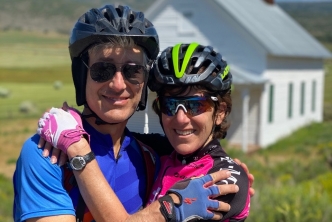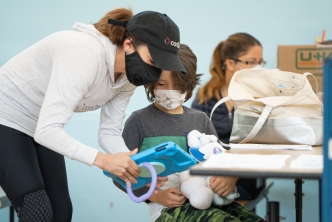
In conversation with Hillary Ford
The Mirnahill Foundation was founded by Kevin and Celeste Ford and named in honor of their three children: Miranda, Nathan, and Hillary. When Kevin and Celeste began planning for retirement and realized they had more to give through their family foundation than anticipated, they decided that they wanted to be more strategic about their giving. Earlier this year, their youngest daughter, Hillary, stepped up to run the Foundation professionally.
How has the Mirnahill Foundation evolved over the years?
My parents founded our family foundation in 2008, and from day one they wanted the three of us [their children] to be involved. For the first decade, that entailed just an annual family meeting where everyone could propose a handful of organizations that they were interested in supporting. Over the years, we accumulated a list of probably 100 organizations and the annual meeting became more of a mechanical process of going through that list, looking them up on Charity Navigator (the extent of our due diligence at the time) and deciding as a family if we wanted to continue supporting those organizations. We were giving small amounts, and it was all over the map with no particular focus area.
About three years ago, we decided that we wanted to be more strategic with our giving, and focus on having deeper relationships with the organizations we were supporting. At our annual meeting in 2018, we invited a strategic advisor to join us to help us understand our shared values and interests. She interviewed each of us individually prior to the meeting and then worked with us to develop our Foundation’s values (family, integrity, and trust) and mission (to educate, empower, and inspire youth through sports). We’re all former athletes, most of us former coaches as well, and we all truly believe that our participation in sports from an early age helped shape our lives. We would love to see a world where every kid, especially those living in low-income communities, has access to everything we believe that sports can offer: a safe after-school activity with positive adult role models that promotes a healthy lifestyle and teaches important life skills like resilience, leadership, confidence, teamwork and community engagement.
How has the Foundation changed since you took over in January?
This year has been an incredible journey so far. I’ve been in total learning mode, participating in conferences, webinars and courses, and joining membership organizations, including The Philanthropy Workshop, SV2, and Magnify Community, which have all been great resources.
My biggest focus this year has been taking the time to really connect with nonprofit organizations, and start to build relationships that give us the confidence to give more. We don’t require a written grant application, because we don’t want to create more work for these nonprofits.
From what I’ve learned in my brief time working in this space, foundations sometimes require a lengthy grant application that they distill into a one-pager for the Board, so I figured why not skip directly to that step? I look up as much information as I can on the potential grantee’s website, GuideStar and Charity Navigator, and then I have a conversation with the nonprofit leader to fill in the rest. Then I put together a one-pager to share with our Board that includes the organization’s mission statement, a description of their programs, some basic financial data, strategic goals and key metrics that they use to measure their impact.
My other big focus has been keeping the family engaged. Beyond our stated mission that we collectively support, we do grantmaking in smaller amounts to support organizations that align with individual family member’s interests, so that everyone feels heard and empowered to have an impact in all of the areas that they care about.
What best practices are you incorporating into your grantmaking?
We’re not doing it alone. Networks like SV2 and Magnify have been great resources, as have other funders. For instance, we’ve discovered some great nonprofits that are aligned with our mission by looking at who the local professional sports teams’ foundations are funding (Warriors, 49ers, Sharks, etc.).
We’re also hoping to build long-term relationships with our grantees so that we can continue to learn from them and better support them. Relationships matter in any business, and we approach our Foundation as a business in that sense. We want to do more than just write checks, so we talk to them about what they need: someone to serve as a sounding board, help plan their fundraising events, volunteer, network, etc. One question that I always ask when meeting with our grantees is “what can we do to better support you?”
And lastly, we’re really trying to reduce the burden on nonprofits. As I mentioned earlier, we don’t require a written grant application, and we always give unrestricted funding. The trends I’m seeing to give more, give sooner and give unrestricted support have really validated that philosophy. I’ll continue to check in with our grantees and review their financials and metrics every year, but at the end of the day, I wholeheartedly trust the nonprofit leaders to do the right thing for their stakeholders, organization and community.
Are there local organizations you’re supporting that you want to highlight?
Absolutely! We don’t have any geographical restrictions tied to our mission, but there are several great local organizations that we support in the youth development through sports arena, including America SCORES Bay Area, Bay Area Women's Sports Initiative (BAWSI), East Palo Alto Tennis & Tutoring, and Girls on the Run Bay Area. We also love supporting the local Boys & Girls Clubs (Peninsula and San Francisco), which offer much broader services including, but not limited to, sports programs — and they’ve really stepped up to support our youth during these unprecedented times. Other local organizations we support outside of our mission focus include Second Harvest Food Bank and Catholic Charities, who are doing great work for the community, especially during this time of incredible need.
The best part of this work for me, hands down, is talking to the nonprofits and seeing the incredible work that they do. I love learning about new organizations from the ones we’re already supporting, and hearing about how they partner — it’s inspiring to see nonprofits supporting each other and working together to tackle big issues.


